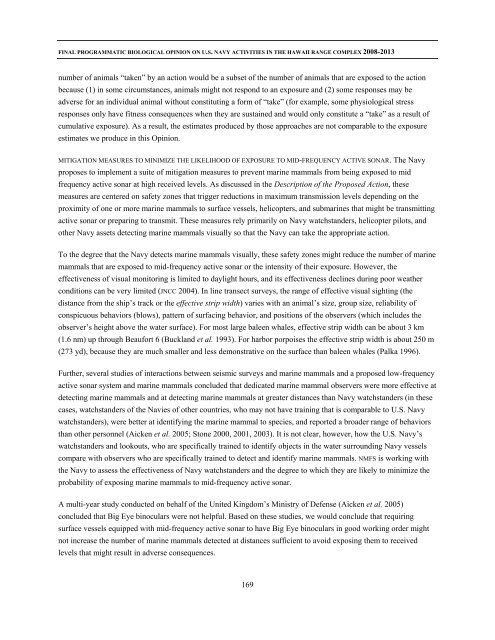NMFS Biological Opinion on U.S. Navy training ... - Govsupport.us
NMFS Biological Opinion on U.S. Navy training ... - Govsupport.us
NMFS Biological Opinion on U.S. Navy training ... - Govsupport.us
You also want an ePaper? Increase the reach of your titles
YUMPU automatically turns print PDFs into web optimized ePapers that Google loves.
FINAL PROGRAMMATIC BIOLOGICAL OPINION ON U.S. NAVY ACTIVITIES IN THE HAWAII RANGE COMPLEX 2008-2013<br />
number of animals “taken” by an acti<strong>on</strong> would be a subset of the number of animals that are exposed to the acti<strong>on</strong><br />
beca<strong>us</strong>e (1) in some circumstances, animals might not resp<strong>on</strong>d to an exposure and (2) some resp<strong>on</strong>ses may be<br />
adverse for an individual animal without c<strong>on</strong>stituting a form of “take” (for example, some physiological stress<br />
resp<strong>on</strong>ses <strong>on</strong>ly have fitness c<strong>on</strong>sequences when they are s<strong>us</strong>tained and would <strong>on</strong>ly c<strong>on</strong>stitute a “take” as a result of<br />
cumulative exposure). As a result, the estimates produced by those approaches are not comparable to the exposure<br />
estimates we produce in this <str<strong>on</strong>g>Opini<strong>on</strong></str<strong>on</strong>g>.<br />
MITIGATION MEASURES TO MINIMIZE THE LIKELIHOOD OF EXPOSURE TO MID-FREQUENCY ACTIVE SONAR. The <strong>Navy</strong><br />
proposes to implement a suite of mitigati<strong>on</strong> measures to prevent marine mammals from being exposed to mid<br />
frequency active s<strong>on</strong>ar at high received levels. As disc<strong>us</strong>sed in the Descripti<strong>on</strong> of the Proposed Acti<strong>on</strong>, these<br />
measures are centered <strong>on</strong> safety z<strong>on</strong>es that trigger reducti<strong>on</strong>s in maximum transmissi<strong>on</strong> levels depending <strong>on</strong> the<br />
proximity of <strong>on</strong>e or more marine mammals to surface vessels, helicopters, and submarines that might be transmitting<br />
active s<strong>on</strong>ar or preparing to transmit. These measures rely primarily <strong>on</strong> <strong>Navy</strong> watchstanders, helicopter pilots, and<br />
other <strong>Navy</strong> assets detecting marine mammals visually so that the <strong>Navy</strong> can take the appropriate acti<strong>on</strong>.<br />
To the degree that the <strong>Navy</strong> detects marine mammals visually, these safety z<strong>on</strong>es might reduce the number of marine<br />
mammals that are exposed to mid-frequency active s<strong>on</strong>ar or the intensity of their exposure. However, the<br />
effectiveness of visual m<strong>on</strong>itoring is limited to daylight hours, and its effectiveness declines during poor weather<br />
c<strong>on</strong>diti<strong>on</strong>s can be very limited (JNCC 2004). In line transect surveys, the range of effective visual sighting (the<br />
distance from the ship’s track or the effective strip width) varies with an animal’s size, group size, reliability of<br />
c<strong>on</strong>spicuo<strong>us</strong> behaviors (blows), pattern of surfacing behavior, and positi<strong>on</strong>s of the observers (which includes the<br />
observer’s height above the water surface). For most large baleen whales, effective strip width can be about 3 km<br />
(1.6 nm) up through Beaufort 6 (Buckland et al. 1993). For harbor porpoises the effective strip width is about 250 m<br />
(273 yd), beca<strong>us</strong>e they are much smaller and less dem<strong>on</strong>strative <strong>on</strong> the surface than baleen whales (Palka 1996).<br />
Further, several studies of interacti<strong>on</strong>s between seismic surveys and marine mammals and a proposed low-frequency<br />
active s<strong>on</strong>ar system and marine mammals c<strong>on</strong>cluded that dedicated marine mammal observers were more effective at<br />
detecting marine mammals and at detecting marine mammals at greater distances than <strong>Navy</strong> watchstanders (in these<br />
cases, watchstanders of the Navies of other countries, who may not have <strong>training</strong> that is comparable to U.S. <strong>Navy</strong><br />
watchstanders), were better at identifying the marine mammal to species, and reported a broader range of behaviors<br />
than other pers<strong>on</strong>nel (Aicken et al. 2005; St<strong>on</strong>e 2000, 2001, 2003). It is not clear, however, how the U.S. <strong>Navy</strong>’s<br />
watchstanders and lookouts, who are specifically trained to identify objects in the water surrounding <strong>Navy</strong> vessels<br />
compare with observers who are specifically trained to detect and identify marine mammals. <str<strong>on</strong>g>NMFS</str<strong>on</strong>g> is working with<br />
the <strong>Navy</strong> to assess the effectiveness of <strong>Navy</strong> watchstanders and the degree to which they are likely to minimize the<br />
probability of exposing marine mammals to mid-frequency active s<strong>on</strong>ar.<br />
A multi-year study c<strong>on</strong>ducted <strong>on</strong> behalf of the United Kingdom’s Ministry of Defense (Aicken et al. 2005)<br />
c<strong>on</strong>cluded that Big Eye binoculars were not helpful. Based <strong>on</strong> these studies, we would c<strong>on</strong>clude that requiring<br />
surface vessels equipped with mid-frequency active s<strong>on</strong>ar to have Big Eye binoculars in good working order might<br />
not increase the number of marine mammals detected at distances sufficient to avoid exposing them to received<br />
levels that might result in adverse c<strong>on</strong>sequences.<br />
169








